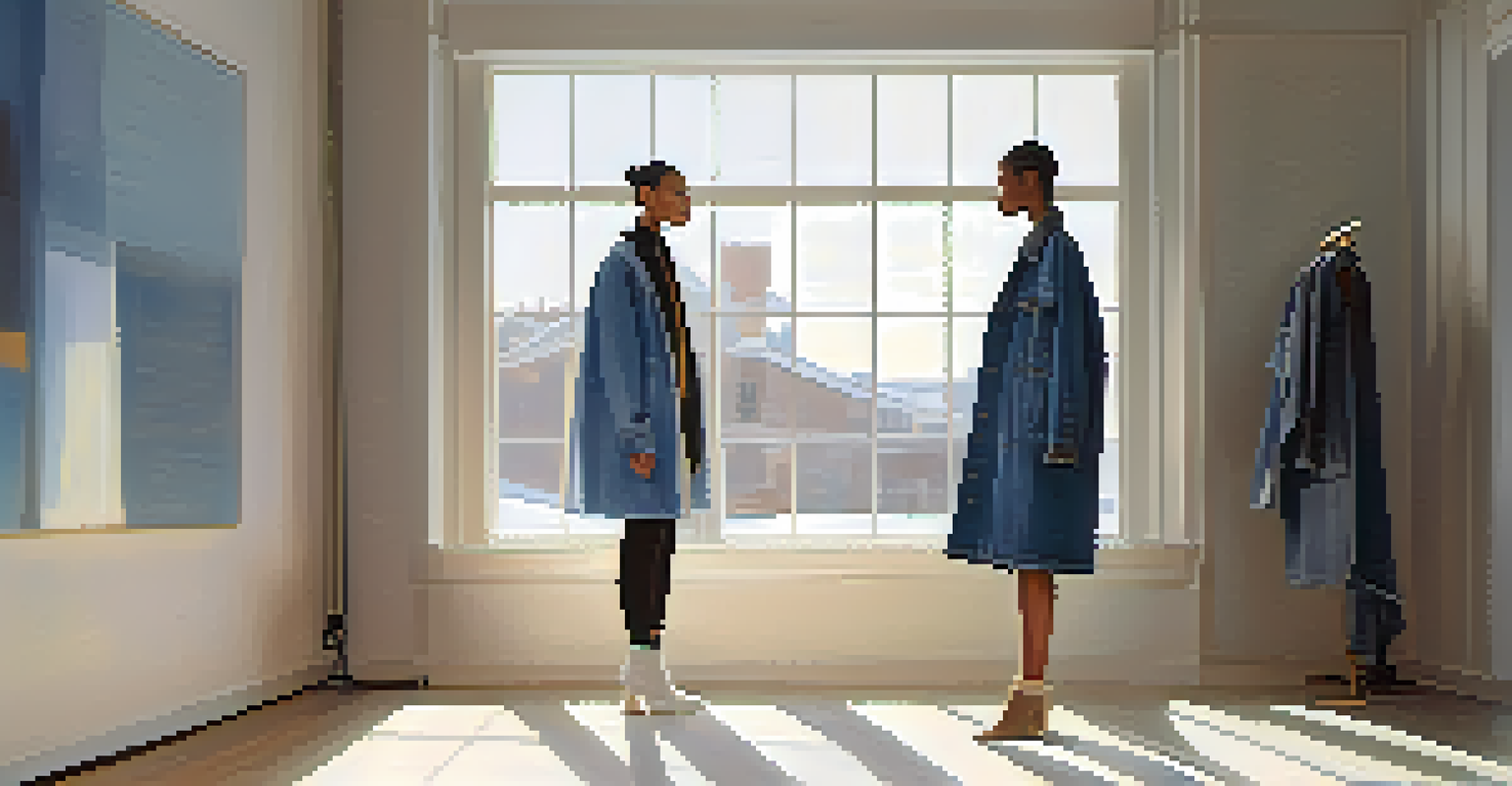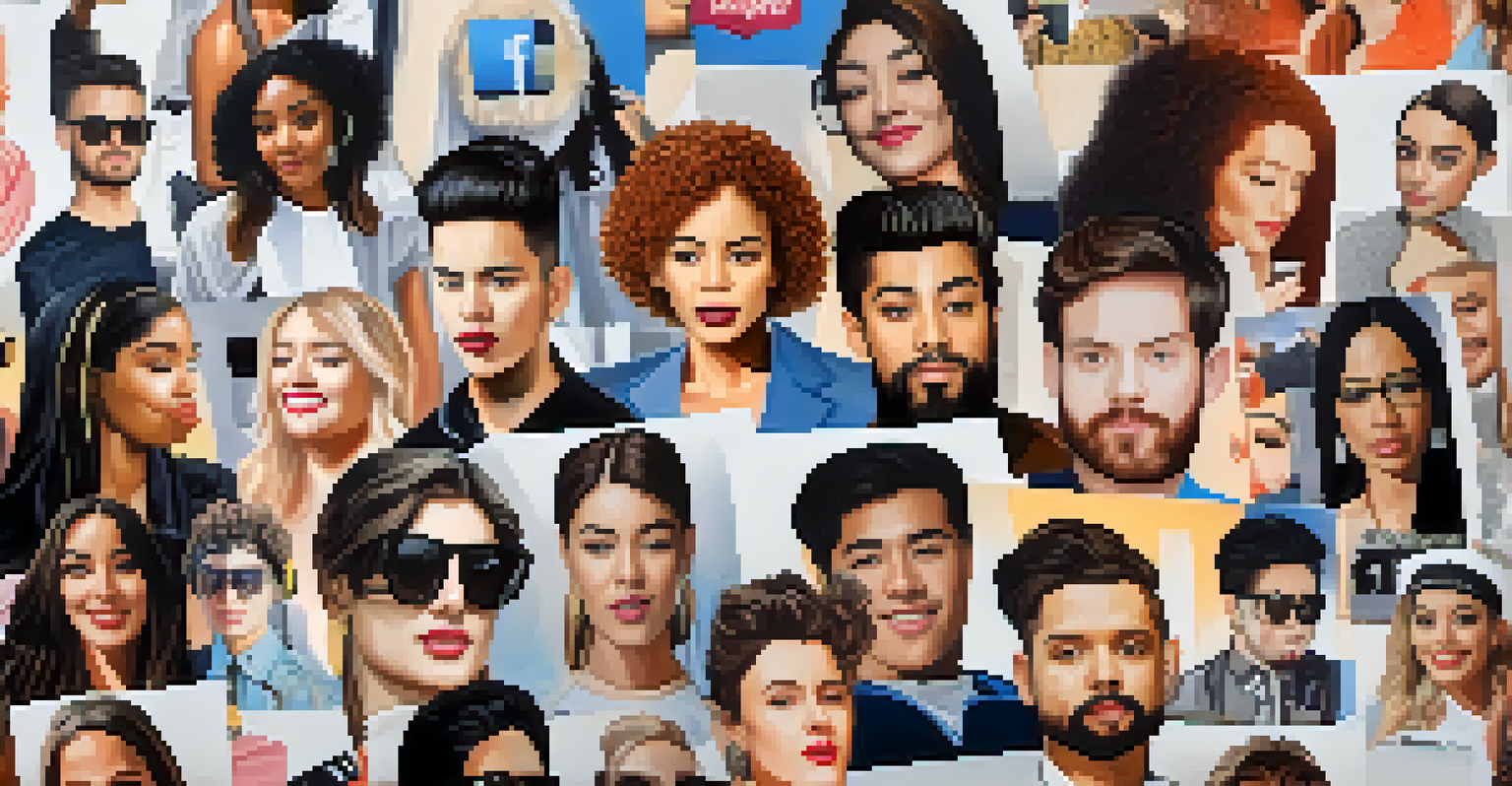The Influence of Social Media on Gender Norms in Fashion

Understanding Gender Norms in Fashion
Gender norms in fashion refer to the societal expectations of how individuals should dress based on their gender. Traditionally, these norms have dictated what is considered 'masculine' or 'feminine' attire, leading to a binary classification of clothing. However, the rise of social media has begun to challenge these conventional standards, paving the way for more fluid expressions of identity.
Fashion is the armor to survive the reality of everyday life.
For instance, men wearing skirts or women opting for tailored suits are becoming increasingly common. This shift not only reflects personal choices but also encourages discussions around gender fluidity and self-expression. Social media platforms showcase these diverse representations, allowing individuals to find inspiration beyond the restrictive norms of the past.
As influencers and brands embrace and showcase gender diversity in fashion, a broader acceptance is taking root. This evolution highlights that fashion can be a powerful tool for expressing one's identity, regardless of gender. With this in mind, it's essential to explore how social media contributes to these changing perceptions.
The Role of Influencers in Shaping Trends
Influencers play a pivotal role in shaping fashion trends, particularly through social media platforms like Instagram and TikTok. By showcasing their unique styles and breaking away from traditional gender norms, they inspire their followers to experiment with their wardrobe choices. Their reach is vast, often leading to the rapid spread of new ideas around fashion and gender.

For example, an influencer who confidently wears clothing that defies gender binaries can encourage others to explore similar styles. This ripple effect helps normalize diverse expressions of gender in fashion, fostering a community that celebrates individuality. The power of influencers lies not just in their style but also in their ability to communicate messages of acceptance and inclusivity.
Fashion Breaks Gender Norms
Social media has empowered individuals to challenge traditional gender norms in fashion, encouraging diverse self-expression.
Moreover, brands are taking notice. Many now collaborate with influencers who embody a more inclusive approach to fashion, further pushing the boundaries of gender norms. This partnership not only enhances brand visibility but also aligns with a growing consumer demand for diversity and representation in fashion.
Social Media Campaigns Encouraging Inclusivity
Various social media campaigns have emerged to promote inclusivity in fashion, challenging outdated gender norms. Campaigns like #GenderlessFashion or #BoyInABlouse encourage individuals to showcase their style without the limitations of traditional gender classifications. These hashtags create a sense of community and solidarity, allowing people to share their unique fashion choices with pride.
You can’t be afraid of what people are going to say, because you’re never going to make everyone happy.
The impact of these campaigns can be profound, as they empower individuals to express themselves authentically. For instance, a young person might feel more confident wearing a dress if they see others doing the same and receiving support online. This visibility helps dismantle the stigma surrounding non-conforming fashion choices and fosters a culture of acceptance.
As these campaigns continue to gain traction, brands are increasingly recognizing the importance of inclusivity. By aligning with these movements, they not only enhance their image but also contribute to a more equitable fashion landscape. This shift represents a significant step towards breaking down the barriers imposed by traditional gender norms.
How Hashtags Shape Conversations Around Gender
Hashtags on social media serve as powerful tools for initiating conversations about gender and fashion. They create a digital space where people can share experiences, stories, and styles that challenge traditional norms. Through the simple act of tagging a post, individuals can connect with like-minded peers and amplify their voices within the fashion community.
For example, hashtags like #FeminineMen or #MasculineWomen have emerged to celebrate those who defy conventional gender presentations. These tags not only highlight diverse style choices but also draw attention to the societal pressures that often dictate how one should dress. By engaging with these hashtags, users can participate in a broader dialogue about gender identity and expression.
Influencers Drive Inclusivity
Influencers play a crucial role in promoting inclusive fashion trends by showcasing styles that defy conventional gender boundaries.
The ability to engage in these conversations online allows for a more inclusive fashion narrative. As users share their stories and style inspirations, they contribute to a growing movement that seeks to redefine gender norms. This collaborative effort not only empowers individuals but also fosters a sense of belonging in the ever-evolving fashion landscape.
The Impact of User-Generated Content
User-generated content (UGC) has become a driving force in the fashion industry, particularly in relation to gender norms. Platforms like Instagram and TikTok allow individuals to showcase their personal styles, providing a counter-narrative to the polished images often presented by brands. This authenticity resonates with audiences, creating a more relatable and inclusive representation of fashion.
When users post images of themselves breaking gender norms, they inspire others to embrace their unique identities. This sharing of personal experiences helps normalize diverse expressions of gender, making it clear that fashion is not confined to traditional expectations. UGC serves as a reminder that fashion can be personal and subjective, allowing individuals to define their own style.
As the fashion landscape continues to evolve, brands are increasingly incorporating UGC into their marketing strategies. By celebrating real people and their stories, they align themselves with the values of authenticity and inclusivity. This shift not only enhances brand loyalty but also contributes to a more diverse representation of gender in fashion.
The Challenge of Maintaining Authenticity
While social media has opened doors for diverse expressions of gender in fashion, it also presents challenges in maintaining authenticity. The pressure to conform to certain aesthetic standards can lead some individuals to feel they must alter their authentic self to gain attention. This struggle can create a paradox where the desire for individuality is overshadowed by the need for acceptance.
For instance, a person may feel compelled to dress in a way that aligns with popular trends rather than their true style. This phenomenon can be particularly pronounced among influencers, who may face scrutiny for their choices. As a result, the quest for authenticity becomes a balancing act between self-expression and the expectations of an audience.
User Content Shapes Fashion Dialogue
User-generated content fosters a more authentic representation of fashion, allowing individuals to share their unique styles and experiences.
To combat this challenge, many are advocating for a return to genuine self-expression. By celebrating unique styles and promoting authenticity, individuals can foster a more supportive environment that values diversity. This shift not only empowers individuals but also enriches the fashion community by allowing a broader range of voices to be heard.
Looking Ahead: The Future of Gender Norms in Fashion
As social media continues to evolve, so too will gender norms in fashion. The increasing visibility of diverse identities and expressions is likely to shape the future landscape of the industry. With more individuals embracing gender fluidity and challenging traditional norms, we can expect to see a shift in how fashion is perceived and consumed.
Brands are already responding to this change, with many incorporating gender-neutral collections and campaigns into their strategies. This evolution represents a significant departure from the rigid classifications of the past, allowing for a more inclusive approach to fashion. The future promises a landscape where personal expression takes precedence over societal expectations.

Ultimately, the influence of social media on gender norms in fashion will continue to grow, driving conversations and inspiring change. By fostering an environment that values diversity and authenticity, we can look forward to a vibrant and inclusive fashion future where everyone feels empowered to express themselves freely.